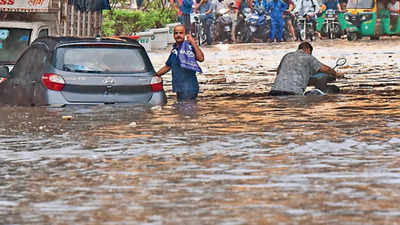- News
- City News
- delhi News
- Delhi weather: 100mm rain in 1 hour on Friday, 25% more than entire June's quota
Trending
Delhi weather: 100mm rain in 1 hour on Friday, 25% more than entire June's quota
Extreme rainfall events, like the recent cloudburst at Safdarjung, are becoming more frequent and intense in north India. The convergence of multiple weather systems, as observed by experts from the University of Reading, has been identified as a key factor contributing to the increased risk of flooding in the region.

NEW DELHI: Safdarjung received 25% more rain in one hour on Friday morning than it normally gets in the entire month of June as a deadly interaction of multiple weather systems led to a cloudburst over areas in central Delhi.

While Friday's convergence of multiple systems was localised over a very small region, this was the third instance in less than two years when extreme rain in the city was caused by an interaction of two or more weather systems.Worryingly, experts and climate models suggest these types of events are likely to increase in frequency and intensity with climate change.
"Between 5am to 6am, Safdarjung recorded nearly 100mm of rain. It was a cloudburst phenomenon with the maximum rain concentrated around the Safdarjung station," IMD chief Mrutyunjay Mohapatra told TOI.
So, what caused such extreme rainfall, the highest single-day spell at Safdarjung since 1996 and the highest in June since 1936? "At that time, two circulations, one over Haryana and another over south Rajasthan-Gujarat, were bringing some moisture from the Arabian Sea. At the same time, there was a low-pressure system over Bay of Bengal near the Odisha coast that was energising the southwest monsoon and pushing these winds towards northwest India. The circulations in the north also attracted the monsoon towards the region, leading to its swift movement towards Delhi-NCR," Mohapatra said.
He said the final piece in the mix was a high-pressure system in the upper layers of atmosphere over Delhi that caused convergence of winds in the lower layers, leading to perfect conditions for intense thunderstorms. "It was a multiple-scale interaction which caused extreme rainfall over a very narrow region. In technical terms, it was a mesoscale convection system," the IMD chief said.
While Friday's conditions differed significantly from previous instances, it was nonetheless the third multi-system convergence causing heavy rain in the capital in less than two years. The previous instances were in July last year and Oct 2022.
These weather interactions have become a prime cause of extreme rainfall in north India in recent years, including the catastrophic Kedarnath deluge of 2013. And climate change could be adding to their destructive potential. "We can be fairly certain that these interactions, when they do happen, will be increasingly linked with extreme rainfall and flooding," said meteorologist Kieran Hunt from the UK's University of Reading, who has been researching on two-system interactions over India.

While Friday's convergence of multiple systems was localised over a very small region, this was the third instance in less than two years when extreme rain in the city was caused by an interaction of two or more weather systems.Worryingly, experts and climate models suggest these types of events are likely to increase in frequency and intensity with climate change.
"Between 5am to 6am, Safdarjung recorded nearly 100mm of rain. It was a cloudburst phenomenon with the maximum rain concentrated around the Safdarjung station," IMD chief Mrutyunjay Mohapatra told TOI.
The normal rainfall for the month of June at Safdarjung is 80.6mm. In a single hour, the month's normal was exceeded by 25%. The day's rainfall, at 228.5mm, was nearly four times the June normal.
So, what caused such extreme rainfall, the highest single-day spell at Safdarjung since 1996 and the highest in June since 1936? "At that time, two circulations, one over Haryana and another over south Rajasthan-Gujarat, were bringing some moisture from the Arabian Sea. At the same time, there was a low-pressure system over Bay of Bengal near the Odisha coast that was energising the southwest monsoon and pushing these winds towards northwest India. The circulations in the north also attracted the monsoon towards the region, leading to its swift movement towards Delhi-NCR," Mohapatra said.
He said the final piece in the mix was a high-pressure system in the upper layers of atmosphere over Delhi that caused convergence of winds in the lower layers, leading to perfect conditions for intense thunderstorms. "It was a multiple-scale interaction which caused extreme rainfall over a very narrow region. In technical terms, it was a mesoscale convection system," the IMD chief said.
While Friday's conditions differed significantly from previous instances, it was nonetheless the third multi-system convergence causing heavy rain in the capital in less than two years. The previous instances were in July last year and Oct 2022.
These weather interactions have become a prime cause of extreme rainfall in north India in recent years, including the catastrophic Kedarnath deluge of 2013. And climate change could be adding to their destructive potential. "We can be fairly certain that these interactions, when they do happen, will be increasingly linked with extreme rainfall and flooding," said meteorologist Kieran Hunt from the UK's University of Reading, who has been researching on two-system interactions over India.
End of Article
FOLLOW US ON SOCIAL MEDIA










